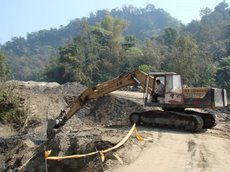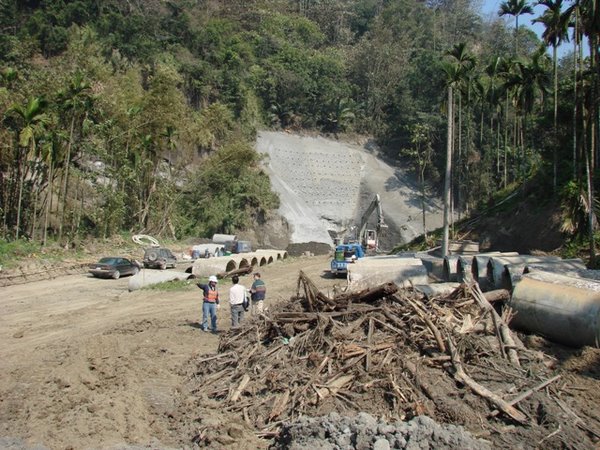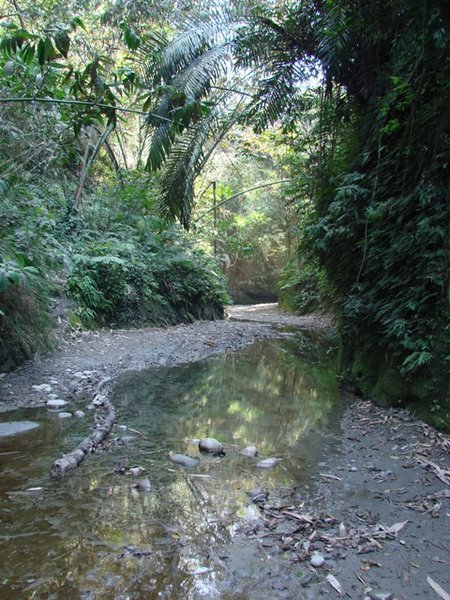
The White-breasted Waterhen Amaurornis phoenicurus is a fairly common waterbird frequenting the reed beds and undergrowth along streams in the area. At dawn and dusk one can often observe them feeding along the edges of the stream and on sand bars in the stream which runs through Huben village.
Huben Bird List
Tuesday, September 29, 2009
White-breasted Waterhen
Posted by
Wild at Heart Legal Defense Association
at
12:15 PM
0
comments
![]()
Monday, September 14, 2009
The proof of the pudding is in the eating: The Chingshuei River after Morakot
One of the major criticisms and concerns over the Hushan Dam project is that the dam will just silt up and become unusable within a very short period. After the devastating earthquake in September 1999 the general area remains highly unstable. Obviously there is a major safety concern with a large dam being constructed in an unstable area that is within an area with an alarming history of earthquakes. If the dam wall fails a lot of people will be in very big trouble.
Lets put aside the safety concerns for a moment and lets just look at the silt issue. It is a known fact that after the big 921 Earthquake in September 1999 large amounts of debris and silt were deposited in the middle and lower reaches of the the Chingshuei River. Silt, large boulders and other flood debris are frequently deposited in the mid and lower reaches after typhoons. Taiwan is usually struck by several typhoons (three to five typhoons on average) each summer. A large lake has formed on the Chingshuei River in the Tsaoling area five times over the past century as a result of debris from earthquakes, typhoons or landslides blocking the channel of the river. The most recent was as a result of the big 1999 earthquake. This lake rapidly silted up and what was left was destroyed by a typhoon in 2005 which resulted in large amounts of silt and flood debris being deposited further downstream. The Jiji weir on the Jhoushuei River within the same area suffers from a major silt problem.
The catchment area for the Chingshuei River is geologically highly unstable as a result of the big 921 Earthquake. With the impact of Typhoon Morakot the area has one again suffered extensive damage. Mountainsides are exposed and scared by landslides and as typhoons hit the area over the next few years it is a certainty that many exposed slopes will come crashing down into the Chingshuei River. Route 149, which largely follows the course of the Chingshuei River has been destroyed. Numerous bridges along the route have been washed away and damaged. Whole sections of the road have been washed away or covered by landslides and flood debris. It will take years to repair the damage. It should be noted that parts of this route were still being repaired as recently as 2006 following the 921 Earthquake.
The big question is why with all this proof are we still trying to build the Hushan Dam? How much proof do we still need before we admit Hushan Dam is an idiotic idea? The forces of nature through earthquakes and typhoons keep reminding us what they do to the Chingshuei River. The government's own Environmental Protection Administration's Environmental Impact Assessment Committee ruled the construction of Hushan Dam illegal. Developers have said the ruling was non-binding and just forged ahead with the project with the backing of the authorities. The fact that the issue still lies before the courts and the courts have yet to rule on the legality of the project have just been brushed aside. The only people that stand to benefit from the construction of the Hushan Dam are the developers. For the people of Taiwan they are undoubtedly funding a highly dangerous and costly white elephant with their tax dollars and stand to gain nothing except more expenses in repairing the damage that the Hushan Dam has and will cause to Taiwan's natural environment.
A series of photos showing some of the devastation to the Chingshuei River valley and Route 149 just upstream of the village of Tsaoling. 













Also see:
Typhoon Morakot: The Writing's on the Wall
Air quality worsens from Typhoon Morakot's dust
Taiwan's Aborigines Suffer More Than Morakot
Posted by
Wild at Heart Legal Defense Association
at
10:30 AM
0
comments
![]()
Tuesday, September 8, 2009
The Pheasant-tailed Jacana - more than a typhoon victim.

One of the reserves devastated by Typhoon Morakot was the Guantian Jacana Reserve in Tainan County. The reserve is a protected area for the threatened Pheasant-tailed Jacana Hydrophasianus chirurgus, a dazzling water bird that moves about elegantly on floating vegitation. Jacanas are often called lilly-trotters. The typhoon struck right in the middle of the jacana breeding season. Nests were wiped out and many jacanas seemed to have disappeared. According to the Taipei Times many birds have returned and some renewed nesting attempts are taking place. We heard about the devastation of the Jacana reserve the day after the typhoon. I was at the reserve just a few weeks before and snapped this shot of a pair of jacana. They were feeding in a water chestnut pond about a kilometer away from the reserve.
The jacana reserve does provide nesting for about fifty pairs of jacana. This is obviously very good but in reality it isn't nearly enough. With no available territories available within the reserve the young have to disperse outside the reserve area. But sadly there is no suitable habitat left for them to establish a territory and breed beyond the reserve so they are faced with a perilous nomadic existence with no breeding. It has been shown that jacana and water chestnut farmers can get along if they want to. The govt just doesn't provide any incentive, motivation or requirement that they do so the jacanas always come off second best.
In reality this reserve can't save the species on Taiwan. Much more needs to be done. We can't take a species and relegate it to just 15 ha of habitat and expect it to just make do there. Is 15 ha all the space we can find in a hearts to give this struggling species? Two hundred birds is all that lies between this species on Taiwan and its extinction. All it takes is a botulinum toxin or outbreak of some avian disease and this highly localised species confined to a single population will be expatriated forever.
If I recall the Taiwan High Speed Rail had to fork out just two million NT$ when the line was built over the species stronghold at Hulupi (Tainan). Two million NT$ can't even buy a house. Yet this pittance is the kind of price we're putting on the heads of this once abundant species that is now down to about just two hundred members on Taiwan. This sadly is what conservation on Taiwan is all about. A little reserve here, a little reserve there and we humans take the rest...
Posted by
Wild at Heart Legal Defense Association
at
3:25 PM
0
comments
![]()
Monday, September 7, 2009
Air quality worsens from Typhoon Morakot's dust



The air quality in central Taiwan has always been a problem. The world's dirtiest coal-fired power plant in Wuchi, Taichung does its bit in greying central skies. Then, the Formosa Plastics plant at Mailiao and various other industrial parks all add to the toxic clouds. Add to that the burning of rice fields, garbage, ghost money and the exhausts of millions of scooters, cars and trucks and you have really scary air. But it doesn't stop there. You need to add dust, too. The lower courses of Taiwan's rivers tend to have very wide floodplains. This is due to the volume of water within rivers increasing dramatically during typhoons. With the building of dams and weirs on large rivers like the Jhoushuei and Chingshuei the greatly reduced flow of water causes the wide river floodplains to really dry out and dust becomes a major problem as a result...and when the Hushan Dam is completed it will only add to the problem. And this dust really helps push down the air quality index when in gets in the mix with all the other pollutants blowing around. Understandably its just got worse in the wake of Typhoon Morakot...much of the destruction and mud resulting from decades of poor land and water management.
See:
Air quality worsens from Typhoon Morakot's dust in the Taipei Times.
Typhoon Morakot: The Writing's on the Wall
River Dust
Posted by
Wild at Heart Legal Defense Association
at
3:38 PM
0
comments
![]()
Friday, September 4, 2009
Ideologically Based Development: What’s the Point of Environmental Impact Assessment?

A recent article on the Wild at Heart Legal Defense Association website titled Ideologically Based Development: What’s the Point of Environmental Impact Assessment? gives some valuable insight into the failings of environmental impact assessment in Taiwan and the type of mindset environmental groups come up against when dealing with the government department appointed to protect Taiwan's environment. Wild’s founding director, Robin Winkler, served a two-year term on the EIA commission.
Posted by
Wild at Heart Legal Defense Association
at
1:08 PM
0
comments
![]()
















